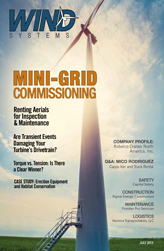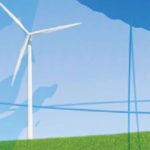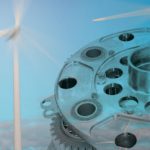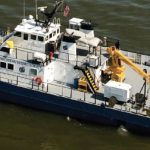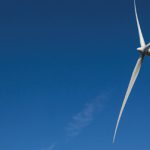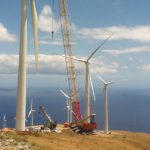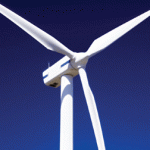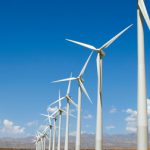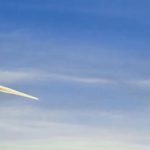More than 2,000 miles from the continental U.S., Hawaii residents have learned the benefits of being self-sustaining. If a good or service cannot be produced locally, then it has to be shipped in. There is much planning, organization, and expense associated with importing these conveniences of modern day living to the islands’ nearly 1.4 million residents.
This holds especially true with regards to bringing power to the islands. If it’s not locally produced, then fuel sources such as diesel, gas and oil are shipped in by barge. This harsh reality is behind the state’s aggressive clean energy policy. State law mandates that by 2030, at least 70 percent of Hawaii’s power comes from clean energy sources, 40 percent of which must be locally produced from renewable sources. With this policy in place, wind energy is beginning to figure heavily into the state’s energy policy. Figure 1
Harnessing the Wind
The Buckner Companies of Graham, N.C. spent the last year with its 660 ton Terex CC 2800-1 NT lattice boom crawler crane helping to erect wind turbines on Oahu and Maui for RMT, Inc. of Madison, Wis. and project owner, First Wind of Boston, Mass. The Kawailoa Wind project consists of 30 turbines on Oahu’s North Shore, generating 69MW of clean energy, enough to supply 5 to 10 percent of Oahu’s annual electric demand, and saving 300,000 barrels of oil each year.
Maui’s Kaheawa Wind II project adds 14 turbines and 21MW of power to the existing wind farm nestled on a ridgeline of the West Maui Mountains. In total, the Kaheawa wind farm generates 51MW of wind-generated clean energy—enough to power 18,700 homes annually. Figure 2
The Kaheawa Wind project is the first wind project in the U.S. with a detailed habitat conservation plan. A staunch believer that an environmentally friendly power source should be built in an environmentally friendly way, First Wind used the plan to be sensitive to the habitat and wildlife needs, while fulfilling the island residents’ need for clean energy.
This presented Buckner Companies and RMT with some interesting on-site challenges during turbine construction. However, these were met through the use of its new Terex CC 2800-1 NT.
Narrow Capacity
The Kaheawa project consisted of 14 turbine pads and most had one thing in common. “The pads were extremely small, and only one site (pad six) had enough space to assemble the crane,” said Jay Lusso, technical services representative for Hayden Murphy Equipment Company. Hayden Murphy is a Terex Cranes distributor who was on site to assist with CC 2800-1 NT rigging and derigging.
The plan, according to Kevin Long, Buckner’s heavy lift project manager, was to erect a turbine and then move the crane under its own power to the next turbine pad without disassembling it. There was only one catch. The roads were extremely narrow. “The roads were only 20 feet wide, which meant a conventional 660-ton capacity crane was too wide to navigate the roads,” Long said. Lusso added, “We could not disturb the property at the sides of the road, since the grasses and habitat were protected.” Figure 3
Conventional 660 ton cranes measure up to 32.5 ft wide to the tracks’ outside edges. Long admitted that the company considered completing the Maui project with a 440 ton crawler crane to navigate the tight roads. In the end, however, “we wanted the higher capacity crane to deal with wind challenges, and we had the narrow track crane on the island,” he said.
Whereas the track footprint of the conventional Terex CC 2800-1 measures over 32 ft, the track width of the Terex CC 2800-1 NT is only 17.4 ft, allowing Buckner’s crews to navigate the narrow roads. Even with the narrow tracks, the crane still offers the high lift capacities customers expect from a 660 ton class crane. Large 16.4 ft long x 4.6 ft wide front/rear outrigger pads work in conjunction with two hydraulically operated side 9.8 x 7.9 ft outrigger pads to give the stability required for lifting heavy loads.
Construction of the 1.5MW turbines on Maui required 276 ft of main boom with a 39.4 ft fixed jib. The crane’s upper structure was equipped with 198 tons of counterweight for the maximum 70- ton lifts to erect the turbines. With constant wind speeds on the West Maui Mountains often reaching 17 mph, RMT’s crews appreciated the strong load chart of the 660 ton crane and its maximum wind load rating of 21.9 mph. “We faced consistently high wind speeds on the project, and the CC 2800-1 NT efficiently and effectively handled the wind,” Long said. “Having the higher capacity crane gave us more working days on the project.”
Once a turbine was finished, crews moved the crane to the next pad. “It was about 100 yd between each turbine pad,” Lusso said. The CC 2800-1 NT’s remote control aided in safely moving the crane from pad to pad. Figure 4
If the narrow roads weren’t challenging enough, the steep grades of the mountainous terrain added to the project’s difficulties. “We were traveling unusually high grades of up to 17.5 percent,” explained Long. With its maximum 10- degree gradeability, the Terex CC 2800-1 NT efficiently handled the steep grades, and its Quadro track drive helped with maneuvering by allowing the tracks to counter rotate to make tight turns.
RMT’s crews started at turbine pad site six and worked their way down the mountain to pad 14. When finished at turbine 14, they moved the CC 2800-1 NT up the mountain without disassembling it to pad one and worked their way back to pad six. Figure 5
Once back to turbine number six in May, they had enough room to disassemble the crane for transport to Oahu. Transport of the crane to and from the port and between islands was arranged by locally owned general/mechanical contractor American Piping & Boiler Co. (APB), of Kapolei, Hawaii. “Moving between islands was logistically challenging, but APB did a fantastic job handling all of the arrangements,” Long said. Reflecting on the steep grade, narrow road width and ample capacity in a high wind application, Long marveled at the benefits offered by the CC 2800-1 NT. “That model crane is the only crane at that capacity that could do the project,” he said.
Mega Power
When using the narrow track crane at the Kawailoa Wind project on Oahu, Buckner noted one additional advantage offered by the CC 2800-1 NT—ease of assembly and disassembly. From June through mid-October, crews used the crane to build 30 of the larger 2.3MW turbines. “Because of the challenging site conditions, we had to assemble and disassemble the crane three times,” Lusso said.
Hayden Murphy was on site each time the crane was disassembled to offer support and consultation. Additionally, the same remote control unit used to move the crane from pad to pad, is also designed to assist with crane assembly. Figure 6
These large turbines required a maximum lift capacity of 105 tons. The crane was equipped with full counterweight, 334.6 ft of main boom and a 39.4 ft fixed jib offering up to 10-degree offset.
Even with the longer boom configuration and 50 percent higher capacity lifting requirement, Buckner did not need to equip the crane with its optional superlift for the project. Long reports this significantly improved crane assembly and disassembly efficiency. “The total disassembly and reassembly process took two to three days,” he said. “If we would have needed the (superlift) derrick, this would have added another full day to the process.”
The CC 2800-1 NT allowed RMT’s crews to efficiently install the larger wind turbines on Oahu as it did for the smaller turbines on Maui. With the opening of these two most recent wind farm projects in Hawaii, the total of First Wind’s turbines operating on Oahu and Maui generate enough clean energy to serve over 40,000 businesses and homes. Figure 7
To ensure these turbines continue to harness the renewable wind energy at peak efficiency, Buckner will keep the Terex CC 2800-1 NT on Oahu for five years. The company has created a joint venture with APB, American Piping & Buckner, to assist with maintenance and service activities.
About the Terex CC 2800-1 NT
The Terex CC 2800 1 NT Crawler Crane offers a high return on investment and is among the most economical and versatile narrow track cranes in the 660 ton class. Using a selection of specially designed accessories, the crane is convertible from standard (CC 2800-1) heavy lift configuration to Narrow Track crane (CC 2800-1 NT) and back, providing outstanding performance in a wide variety of applications, including wind farm sites, where extra heavy load capacity is a necessity.
Recognizing the high potential of the onshore wind turbine market and the subsequent need for dedicated equipment in the 660 ton class, Terex Cranes developed the CC 2800-1 NT (narrow track) from the standard CC 2800-1 version to suit specific wind farm construction requirements. Equipped with its Narrow Track chassis, the Terex CC 2800-1 NT can be driven from one construction site to the next, even when access is tight, while fully rigged with counterweights, 334.6 ft main boom and LF 2 fixed jib, saving precious time and increasing productivity. Figure 8
The CC 2800 1 NT version is based on a conventional CC 2800-1, where the standard chassis (27.6 ft track width) is replaced with the Narrow Track Kit comprising of: chassis track with 5.3 m outer track width and front and rear outriggers, two 16.4 ft long x 4.6 ft wide outrigger pads for both front and rear outriggers, two side outriggers with 9.8 x 7.9 ft outrigger pads, counterweight suspension frame to lower the center of gravity and control system with remote control unit and full color graphic display monitor at the rear of the crane chassis. To provide stability and quick rigging times, both front and rear outrigger beams remain connected to the carrier.
The Companies Buckner Companies
With over 65 years of providing reliable, quality and safe services to the commercial and industrial markets, Buckner has earned its reputation as a nationally recognized leader for steel and precast erection and heavy lift cranes services. Buckner builds long term relationships with its customers based on confidence, trust and integrity. Offering exceptional project management, field supervision and experienced field crews, Buckner exceeds the client’s expectations safely, cost effectively and ahead of schedule.
For more information on Buckner Companies, visit www.bucknercompanies.com.
First Wind
First Wind is an independent wind energy company exclusively focused on the development, financing, construction, ownership and operation of the utility scale wind energy projects in the United States. Headquartered in Boston, Mass., First Wind focuses on developing and operating wind energy projects in the Northeastern and western regions of the continental United States and in Hawaii.
For more information on First Wind, visit www.firstwind.com.
Terex
Terex Corporation is a diversified global manufacturer of a broad range of equipment that is focused on delivering reliable, customer driven solutions for many applications, including the construction, infrastructure, quarrying, mining, shipping, transportation, refining, energy, utility and manufacturing industries. Terex reports in five business segments: Aerial Work Platforms; Construction; Cranes; Material Handling & Port Solutions; and Materials Processing. Terex offers financial products and services to assist in the acquisition of equipment through Terex Financial Services. More information can be found at www.terex.com.



















